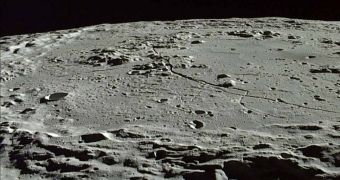As the Apollo program unfolded, astronauts who went on lunar missions brought back important amounts of Moon rocks for studying. This diversity of materials allowed geologists to draw a clear picture of the minerals that can be found on our planet's natural satellite, but what it didn't do was help investigators understand what was going on underneath the surface. However, this changed recently in a new study, as experts investigated the lunar craters in more detail, ScienceNow reports.
The new information was collected using the Kaguya lunar orbiter, which belongs to the Japan Aerospace Exploration Agency (JAXA). The spacecraft was able to identify that the main mineral in the lunar mantle is a substance called olivine, also found in the rim of craters on the surface. The finding is extremely important, as it certifies a long-standing theory about how the Moon and Earth's mantles resemble each other. The discovery also lends further credence to the theory that the two bodies emerged from a single collision, which took place billions of years ago.
Geologists believe that two Mars-sized bodies slammed into each other when the solar system was very young, and that this impact led to the formation of the Earth and the Moon. Given that the mineral olivine makes up an important part of our planet's mantle, experts expected to find it in the Moon as well. However, evidence of this was not immediately made available from the Apollo rock samples. But Kaguya data collected at over 70 million points on the surface of the Moon revealed the presence of the mineral in concentric rings, around craters made in places where the crust was thinnest.
“The finding is exciting [because] for the first time there appears to be evidence for rocks exposed on the surface of the moon that do not originate from the upper lunar crust,” explains geochemist Carsten Munker, who is based in Germany, at the University of Cologne. The new conclusions “are very important for understanding how the early crust and mantle of [bodies like the Moon] form and evolve in the first few hundred million years,” concludes Brown University planetary scientist Carle Pieters, adding that the main direction of research now is determining whether the olivine came from the mantle, or if it originated in the lower portions of the crust.
As the Apollo program unfolded, astronauts who went on lunar missions brought back important amounts of Moon rocks for studying. This diversity of materials allowed geologists to draw a clear picture of the minerals that can be found on our planet's natural satellite, but what it didn't do was help investigators understand what was going on underneath the surface. However, this changed recently in a new study, as experts investigated the lunar craters in more detail, ScienceNow reports.
The new information was collected using the Kaguya lunar orbiter, which belongs to the Japan Aerospace Exploration Agency (JAXA). The spacecraft was able to identify that the main mineral in the lunar mantle is a substance called olivine, also found in the rim of craters on the surface. The finding is extremely important, as it certifies a long-standing theory about how the Moon and Earth's mantles resemble each other. The discovery also lends further credence to the theory that the two bodies emerged from a single collision, which took place billions of years ago.
Geologists believe that two Mars-sized bodies slammed into each other when the solar system was very young, and that this impact led to the formation of the Earth and the Moon. Given that the mineral olivine makes up an important part of our planet's mantle, experts expected to find it in the Moon as well. However, evidence of this was not immediately made available from the Apollo rock samples. But Kaguya data collected at over 70 million points on the surface of the Moon revealed the presence of the mineral in concentric rings, around craters made in places where the crust was thinnest.
“The finding is exciting [because] for the first time there appears to be evidence for rocks exposed on the surface of the moon that do not originate from the upper lunar crust,” explains geochemist Carsten Munker, who is based in Germany, at the University of Cologne. The new conclusions “are very important for understanding how the early crust and mantle of [bodies like the Moon] form and evolve in the first few hundred million years,” concludes Brown University planetary scientist Carle Pieters, adding that the main direction of research now is determining whether the olivine came from the mantle, or if it originated in the lower portions of the crust.

 14 DAY TRIAL //
14 DAY TRIAL //